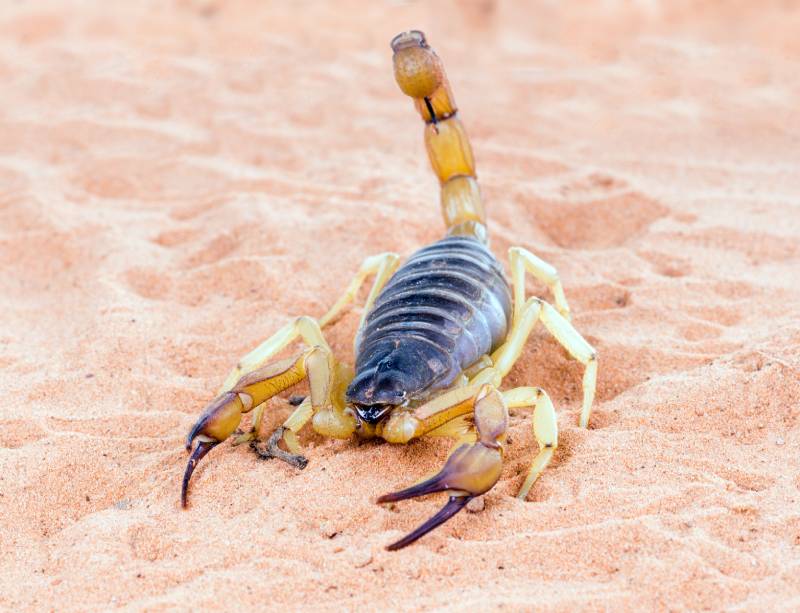The Desert Hairy Scorpions are the largest scorpion species in the United States!
Due to their size and beauty, the Desert Hairy Scorpions Hadrurus spp. are popular arachnids to keep as pets in captivity. There are approximately eight Hadrurus species but there are three Giant Hairy Scorpions that are most familiar. These Giant Hairy Scorpions are notable because they are the largest species of scorpions in the United States, reaching up to about 6 inches in length.
The Desert Hairy Scorpion H. hirsutus is perhaps the best known, followed by the Giant Desert Hairy Scorpion or Arizona Desert Hairy Scorpion H. arizonensis, and the Black Back Desert Hairy Scorpion or Northern Desert Hairy Scorpion H. spadix.
The color patterns of the Desert Hairy Scorpions are somewhat variable, but the differences between the species are negligible. They are mostly a pale, yellow straw color with varying amounts of black on their backs and heads. Like many scorpions, the Desert Hairy Scorpion H. hirsutus fluoresces under ultraviolet light. This glowing gives away their position at night to collectors carrying portable black lights. This adds to the large numbers of this species found in captivity and probably why it is the best known of the group.
Desert Hairy Scorpions are quite hardy when offered the proper enclosure and they require very little maintenance. Although they only live 7 to 10 years in the wild, Giant Hairy Scorpions are known to live in excess of twenty years in captivity. These desert scorpions are not considered dangerous but they are quite defensive. They will readily sting if given the opportunity and when they feel cornered or in danger. The sting is painful, but usually of little medical importance.
- For more information on keeping scorpions, see: Keeping Arachnids and Other Arthropods as Pets
Scientific Classification
| Kingdom: | Animalia |
| Phylum: | Arthropoda |
| Class: | Arachnida |
| Order: | Scorpiones |
| Family: | Caraboctonidae |
| Genus: | Hadrurus |
| Species: | spadix |
Scientific Name
- Hadrurus hirsutus – Wood, 1863
- Hadrurus arizonensis – Ewing, 1928
- Hadrurus aztecus – Pocock, 1902, Mexican scorpion
- Hadrurus concolor – Stahnke, 1971
- Hadrurus gertschi – Soleglad, 1976
- Hadrurus obscurus – Williams, 1970
- Hadrurus pinteri – Stahnke, 1971
- Hadrurus spadix – Stahnke,1940
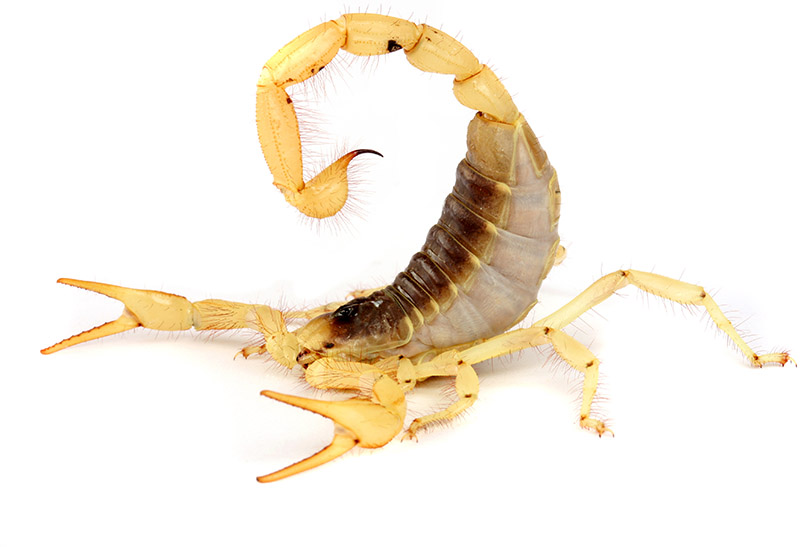
Habitat: Distribution/Background
The first of the Desert Hairy Scorpions Hadrurus spp. was described by Wood in 1863, and the other species were described throughout the 1900’s. These scorpions are found in the Southern and western parts of the United States, including New Mexico, Arizona, Nevada, southern California, and south into Mexico and Baja Mexico. Other common names they are known by are Giant Hairy Scorpions.
Familiar large desert scorpion species include:
Desert Hairy Scorpion Hadrurus hirsutus
The Desert Hairy Scorpion was first described by by Wood in 1863. They are found in Cabo San Lucas, Baja California Sur, and Mexico.Giant Desert Hairy Scorpion Hadrurus arizonensis
The Giant Desert Hairy Scorpion was described by Ewing in 1928. Other common names they are known by are Arizona Desert Hairy Scorpion and Arizona Hairy Scorpion. They are found in southern California, west central Arizona, southern Nevada, northern Baja California, and northwestern Sonora, Mexico. The subspecies H. arizonensis austrinus are found only in central Baja California along an east coast volcanic area.Northern Desert Hairy Scorpion Hadrurus spadix
The Northern Desert Hairy Scorpion was described by Stahnke in 1940. Other common names they are known by are Blacktop Hairy Scorpion, Black Back Desert Hairy Scorpions, Black-back scorpion, and Black Hairy Scorpion. They are found in in northwest Arizona, California, Utah, southern Nevada, Oregon, and Idaho.
Status
The Hadrurus spp. are not on the IUCN Red List for Endangered Species.
Description
Desert Hairy Scorpions are the largest specimens of scorpions in the United States. They can reach 4 to 6″ (11 – 15 cm) in length. There are several “morphs” or subspecies but most are pale to straw yellow in color with darker back plates and dark spots on their legs and claws. They live 20 years or more in captivity.
The Northern Desert Hairy Scorpion H. spadix and the Giant Desert Hairy Scorpion H. arizonensis are almost indistinguishable, with very subtle color pattern differences. The easiest way to distinguish them is by the intensity of the black on their backs and the amount of black on the head and around the eyes. The H. spadix is solidly black all the way up to the eyes, while the black of the H. arizonensis is more faded and diminishes as it reaches the head. Also the area around its eyes will be yellow while it will be black on the H. spadix.
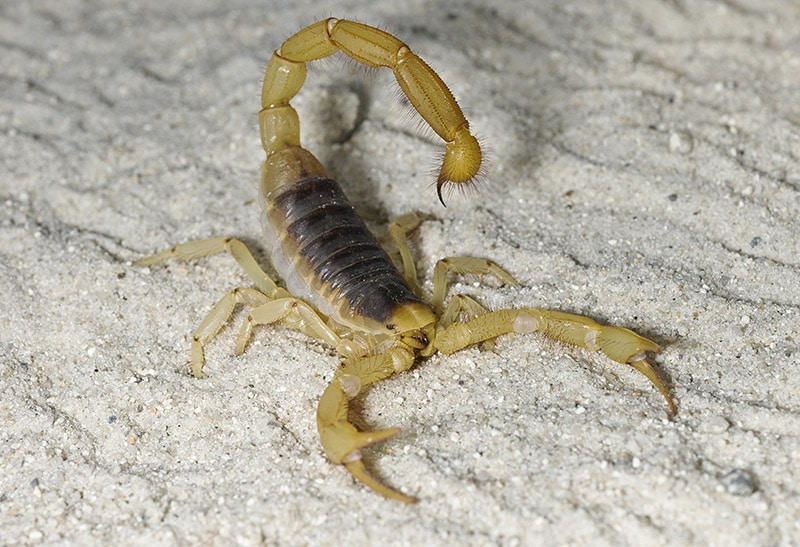
Food and Feeding
In the wild these scorpions feed on large insects such as locusts and solifugids. They are reportedly a major predator of smaller species of scorpions such as Vejovis spinigerus as well. In captivity Desert Hairy Scorpions will feed on crickets and other insects. They will thrive with weekly feedings, requiring little additional water and minimal maintenance.
Housing
The Desert Hairy Scorpions are found in burrows in sandy scrub areas. As desert dwellers, they are extremely sensitive to water and humidity. Their environment should not be kept moist. These Giant Hairy Scorpions have adapted to getting their water from the animals they feed on.
They are aggressive and defensive. They can be kept individually in a 2 1/2 to 5-gallon terrarium. Provide 3 – 4″ (8 – 10 cm) of sand on the bottom. No decorations are really needed, but you can add a log or driftwood for a simple shelter.
Temperature and humidity requirements:
Keep the enclosure maintained at about at 75° – 90 °F with a humidity level of 55 to 55%. The amount of moisture in the enclosure is very important, too much has been known to kill these scorpions.
Cage Care
A good habit to get into is cleaning up any uneaten prey items the day after feeding your scorpion as decaying organic matter commonly attracts mites, fungus, mold and other potentially harmful organisms into the enclosure. If your pet has recently molted, remove uneaten prey items immediately. Newly molted scorpions are vulnerable until their exoskeletons hardens.
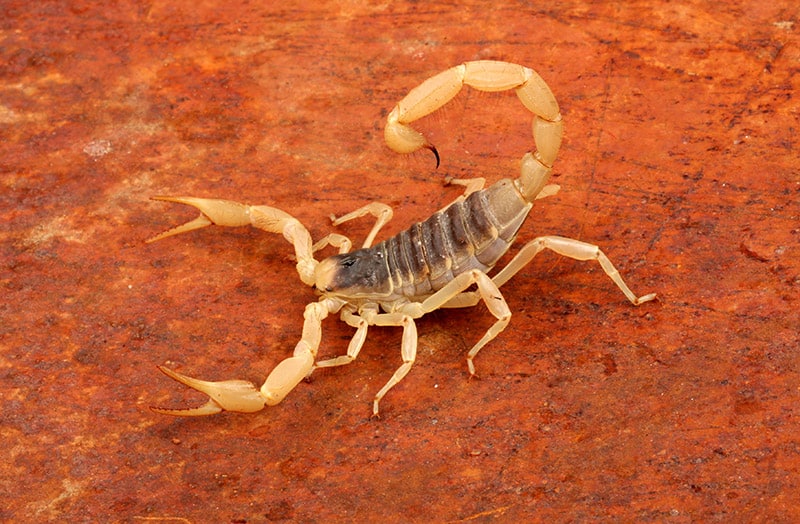
Behavior
The Desert Hairy Scorpion is aggressive and active. They are not social and should be housed individually. They spend a great deal of time using their strong claws and legs for digging and moving earth in the enclosure.
Handling
The Desert Hairy Scorpion is aggressive and will readily sting if given the opportunity. The sting is painful, but usually of little medical importance. Use paintbrushes, deli cups, foam-covered tweezers, and coated rubber gloves to move this scorpion as it can potentially give a painful sting. Scorpions are best considered display animals rather than “hands-on” pets.
Reproduction
Female Hadrurus are often bulkier and have thinner pincers than the males. These differences, however, can be subtle. The pectines on the underside of scorpions can be inspected to give the you an idea of their scorpion’s sex. Place the scorpion in a clear plastic tub and hold it up to inspect the underside of the scorpion. Typically, males have longer combs on their pectines and females have shorter and often fewer combs on their pectines.
The male quickly grasps the pincers of the female and begins a shaking action known as “juddering”. Then, after a short shoving match, the male deposits a spermatophore onto the substrate and positions the female over the packet of sperm. The female lowers her abdomen and picks up the spermatophore into her genital opening. The two separate and often beat a hasty retreat in opposite directions.
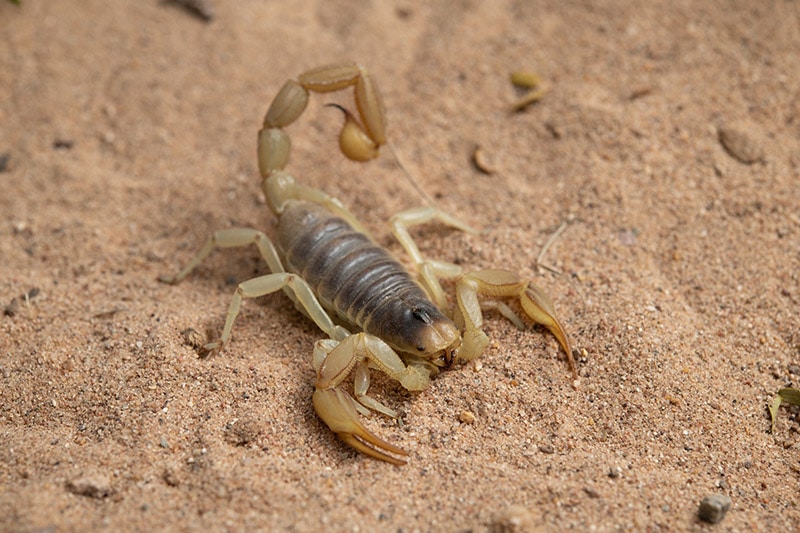
Diseases: Ailments/Treatments
Scorpions are generally quite hardy and adaptable if they are provided with the right environment. A few signs that may indicate that your pet is not acting or feeling normal are a loss of appetite, acting listless or sluggish, having an overly swollen stomach, and missing or deformed limbs. Another problem can be an infestation of mites.
- Molting
One of the most common reasons for the death in scorpions is the molt. The scorpion has a tough outer covering, a cuticle, that forms a rigid exoskeleton. All scorpions must shed their old exoskeleton and secrete a new one in order to grow, this is called the molt. Scorpions will molt from 6 to 10 times during their lifetime. This molting process takes a lot of energy and they are very vulnerable for a couple of days after the molt until their new skin hardens
For about 24 hours prior to molting it is not unusual for a scorpion to get quite sluggish.
A difficult molt can result in lost or deformed limbs, or death. This is thought to be related to humidity levels. There can be either too much humidity or too little, depending on the species. In captivity a lot of immature scorpions die during the molting process. - Other Problems
Though many scorpions can go for long periods of time without eating, overfeeding can cause an overly swollen stomach as well as the loss of appetite, and even death. The stomach can be slightly swollen from regular eating, and this is not a problem.
Another problem can be an infestation of Mites. Uneaten food can attract mites, which are very dangerous and stressful to scorpions. Be sure to remove old food.
Availability
Desert Hairy Scorpions are commonly available from any dealers that offer a good selection of scorpions.
The Desert Hairy Scorpion is commonly abundant in certain areas. Due to the enthusiasm of some invertebrate collectors in Arizona and Nevada, captive caught specimens are regularly available. The only downfall to this is that large numbers are being collected by overzealous collectors. Though these scorpions are quite hardy when offered the proper enclosures, many of these specimens are lost to dehydration.
Featured Image Credit: IrinaK, Shutterstock
